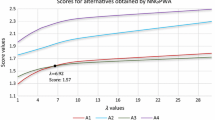Abstract
A single-valued neutrosophic set is a special case of neutrosophic set. It has been proposed as a generalization of crisp sets, fuzzy sets, and intuitionistic fuzzy sets in order to deal with incomplete information. In this paper, a new approach for multi-attribute group decision-making problems is proposed by extending the technique for order preference by similarity to ideal solution to single-valued neutrosophic environment. Ratings of alternative with respect to each attribute are considered as single-valued neutrosophic set that reflect the decision makers’ opinion based on the provided information. Neutrosophic set characterized by three independent degrees namely truth-membership degree (T), indeterminacy-membership degree (I), and falsity-membership degree (F) is more capable to catch up incomplete information. Single-valued neutrosophic set-based weighted averaging operator is used to aggregate all the individual decision maker’s opinion into one common opinion for rating the importance of criteria and alternatives. Finally, an illustrative example is provided in order to demonstrate its applicability and effectiveness of the proposed approach.
Similar content being viewed by others
References
Hwang CL, Yoon K (1981) Multiple attribute decision making: methods and applications. Springer, New York
Brans JP, Vinvke P, Mareschal B (1986) How to select and how to rank projects: the PROMETHEE method. Eur J Oper Res 24:228–238
Opricovic S, Tzeng GH (2004) Compromise solution by MCDM methods: a comparative analysis of VIKOR and TOPSIS. Eur J Oper Res 156:445–455
Roy B (1991) The outranking approach and the foundations of ELECTRE methods. Theory Decis 31:49–73
Zadeh LA (1965) Fuzzy sets. Inf Control 8:338–353
Chen CT (2000) Extensions of the TOPSIS for group decision making under fuzzy environment. Fuzzy Sets Syst 114:1–9
Atanassov KT (1986) Intuitionistic fuzzy sets. Fuzzy Sets Syst 20:87–96
Boran FE, Genc S, Kurt M, Akay D (2009) A multi-criteria intuitionistic fuzzy group decision making for supplier selection with TOPSIS method. Expert Syst Appl 36(8):11363–11368
Pramanik S, Mukhopadhyaya D (2011) Grey relational analysis based intuitionistic fuzzy multi-criteria group decision-making approach for teacher selection in higher education. Int J Comput Appl 34(10):21–29
Smarandache F (1999) A unifying field in logics. Neutrosophy: neutrosophic probability, set and logic. American Research Press, Rehoboth
Wang H, Smarandache F, Zhang YQ, Sunderraman R (2010) Single valued neutrosophic sets. Multispace Multistruct 4:410–413
Ye J (2013) Multicriteria decision-making method using the correlation coefficient under single-valued neutrosophic environment. Int J Gen Syst 42(4):386–394
Ye J (2013) Single valued neutrosophic cross entropy for multicriteria decision making problems. Appl Math Model 38:1170–1175
Biswas P, Pramanik S, Giri BC (2014) Entropy based grey relational analysis method for multi-attribute decision-making under single valued neutrosophic assessments. Neutrosophic Sets Syst 2:102–110
Biswas P, Pramanik S, Giri BC (2014) A new methodology for neutrosophic multi-attribute decision making with unknown weight information. Neutrosophic Sets Syst 3:42–52
Zhang HY, Wang JQ, Chen XH (2014) Interval neutrosophic sets and their application in multi-criteria decision making problems. Sci World J. doi:10.1155/2014/645953
Ye J (2014) A multi-criteria decision-making method using aggregation operators for simplified neutrosophic sets. J Intell Fuzzy Syst 26:2459–2466
Chi P, Liu P (2013) An extended TOPSIS method for the multi-attribute decision making problems on interval neutrosophic set. Neutrosophic Sets Syst 1:63–70
Rivieccio U (2008) Neutrosophic logics: prospects and problems. Fuzzy Sets Syst 159:1860–1868
Ghaderi SF, Azadeh A, Nokhandan BP, Fathi E (2012) Behavioral simulation and optimization of generation companies in electrical markets by fuzzy cognitive map. Expert Syst Appl 39:4635–4646
Smarandache F (2005) Neutrosophic set: a generalization of the intuitionistic fuzzy set. Int J Pure Appl Math 24:287–297
Liu P, Wang Y (2014) Multiple attribute decision making method based on single-valued neutrosophic normalized weighted Bonferroni mean. Neural Comput Appl 25:2001–2010
Majumdar P, Samanta SK (2013) On similarity and entropy of neutrosophic sets. J Intell Fuzzy Syst. doi:10.3233/IFS-130810
Dezert J (2002) Open questions in neutrosophic inferences. Mult Valued Log Intern J 8:439–472
Author information
Authors and Affiliations
Corresponding author
Rights and permissions
About this article
Cite this article
Biswas, P., Pramanik, S. & Giri, B.C. TOPSIS method for multi-attribute group decision-making under single-valued neutrosophic environment. Neural Comput & Applic 27, 727–737 (2016). https://doi.org/10.1007/s00521-015-1891-2
Received:
Accepted:
Published:
Issue Date:
DOI: https://doi.org/10.1007/s00521-015-1891-2




